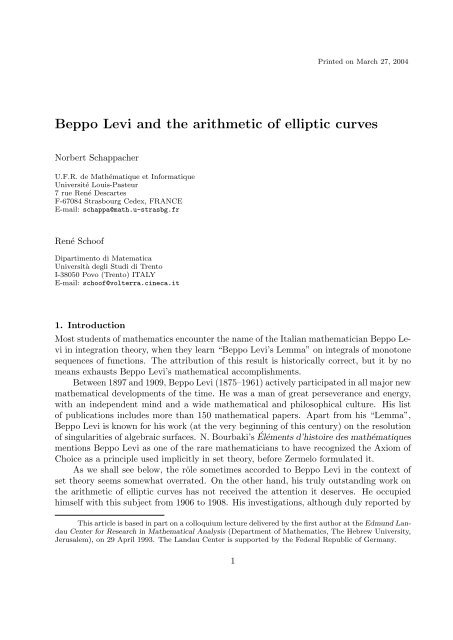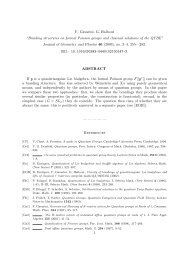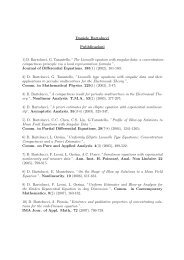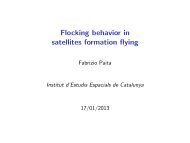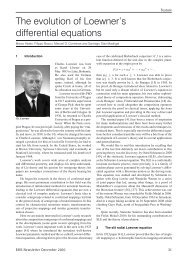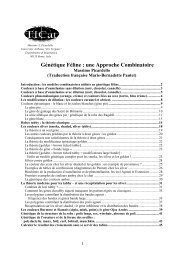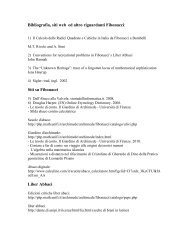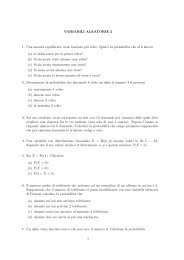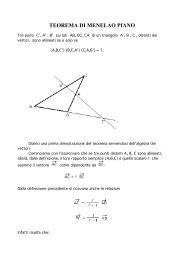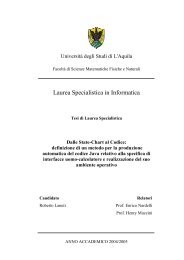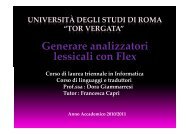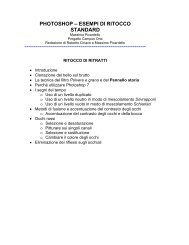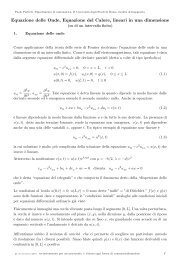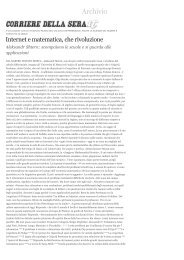Beppo Levi and the arithmetic of elliptic curves - Dipartimento di ...
Beppo Levi and the arithmetic of elliptic curves - Dipartimento di ...
Beppo Levi and the arithmetic of elliptic curves - Dipartimento di ...
Create successful ePaper yourself
Turn your PDF publications into a flip-book with our unique Google optimized e-Paper software.
Printed on March 27, 2004<br />
<strong>Beppo</strong> <strong>Levi</strong> <strong>and</strong> <strong>the</strong> <strong>arithmetic</strong> <strong>of</strong> <strong>elliptic</strong> <strong>curves</strong><br />
Norbert Schappacher<br />
U.F.R. de Mathématique et Informatique<br />
Université Louis-Pasteur<br />
7 rue René Descartes<br />
F-67084 Strasbourg Cedex, FRANCE<br />
E-mail: schappa@math.u-strasbg.fr<br />
René Scho<strong>of</strong><br />
<strong>Dipartimento</strong> <strong>di</strong> Matematica<br />
Università degli Stu<strong>di</strong> <strong>di</strong> Trento<br />
I-38050 Povo (Trento) ITALY<br />
E-mail: scho<strong>of</strong>@volterra.cineca.it<br />
1. Introduction<br />
Most students <strong>of</strong> ma<strong>the</strong>matics encounter <strong>the</strong> name <strong>of</strong> <strong>the</strong> Italian ma<strong>the</strong>matician <strong>Beppo</strong> <strong>Levi</strong><br />
in integration <strong>the</strong>ory, when <strong>the</strong>y learn “<strong>Beppo</strong> <strong>Levi</strong>’s Lemma” on integrals <strong>of</strong> monotone<br />
sequences <strong>of</strong> functions. The attribution <strong>of</strong> this result is historically correct, but it by no<br />
means exhausts <strong>Beppo</strong> <strong>Levi</strong>’s ma<strong>the</strong>matical accomplishments.<br />
Between 1897 <strong>and</strong> 1909, <strong>Beppo</strong> <strong>Levi</strong> (1875–1961) actively participated in all major new<br />
ma<strong>the</strong>matical developments <strong>of</strong> <strong>the</strong> time. He was a man <strong>of</strong> great perseverance <strong>and</strong> energy,<br />
with an independent mind <strong>and</strong> a wide ma<strong>the</strong>matical <strong>and</strong> philosophical culture. His list<br />
<strong>of</strong> publications includes more than 150 ma<strong>the</strong>matical papers. Apart from his “Lemma”,<br />
<strong>Beppo</strong> <strong>Levi</strong> is known for his work (at <strong>the</strong> very beginning <strong>of</strong> this century) on <strong>the</strong> resolution<br />
<strong>of</strong> singularities <strong>of</strong> algebraic surfaces. N. Bourbaki’s Éléments d’histoire des mathématiques<br />
mentions <strong>Beppo</strong> <strong>Levi</strong> as one <strong>of</strong> <strong>the</strong> rare ma<strong>the</strong>maticians to have recognized <strong>the</strong> Axiom <strong>of</strong><br />
Choice as a principle used implicitly in set <strong>the</strong>ory, before Zermelo formulated it.<br />
As we shall see below, <strong>the</strong> rôle sometimes accorded to <strong>Beppo</strong> <strong>Levi</strong> in <strong>the</strong> context <strong>of</strong><br />
set <strong>the</strong>ory seems somewhat overrated. On <strong>the</strong> o<strong>the</strong>r h<strong>and</strong>, his truly outst<strong>and</strong>ing work on<br />
<strong>the</strong> <strong>arithmetic</strong> <strong>of</strong> <strong>elliptic</strong> <strong>curves</strong> has not received <strong>the</strong> attention it deserves. He occupied<br />
himself with this subject from 1906 to 1908. His investigations, although duly reported by<br />
This article is based in part on a colloquium lecture delivered by <strong>the</strong> first author at <strong>the</strong> Edmund L<strong>and</strong>au<br />
Center for Research in Ma<strong>the</strong>matical Analysis (Department <strong>of</strong> Ma<strong>the</strong>matics, The Hebrew University,<br />
Jerusalem), on 29 April 1993. The L<strong>and</strong>au Center is supported by <strong>the</strong> Federal Republic <strong>of</strong> Germany.<br />
1
him at <strong>the</strong> 1908 International Congress <strong>of</strong> Ma<strong>the</strong>maticians in Rome, appear to be all but<br />
forgotten. This is striking because in this work <strong>Beppo</strong> <strong>Levi</strong> anticipated explicitly, by more<br />
than 60 years, a famous conjecture made again by Andrew P. Ogg in 1970, <strong>and</strong> proved by<br />
Barry Mazur in 1976.<br />
Shortly before his retirement, fate held in store for <strong>Beppo</strong> <strong>Levi</strong> a tremendous challenge<br />
which he more than lived up to: <strong>the</strong> last twenty years <strong>of</strong> his long life were devoted to<br />
buil<strong>di</strong>ng up ma<strong>the</strong>matics in Rosario, Argentina, <strong>the</strong> place where he had emigrated.<br />
In this article we briefly describe <strong>Beppo</strong> <strong>Levi</strong>’s life <strong>and</strong> ma<strong>the</strong>matical work, with special<br />
emphasis on his forgotten contributions to <strong>the</strong> <strong>arithmetic</strong> <strong>of</strong> <strong>elliptic</strong> <strong>curves</strong>. For more<br />
detailed biographical information <strong>the</strong> interested reader is referred to <strong>the</strong> extremely well<br />
researched article [Coen 1994]; a convenient list <strong>of</strong> <strong>Beppo</strong> <strong>Levi</strong>’s publications is contained<br />
in [Terracini 1963, 601–606]. 1 <strong>Beppo</strong> <strong>Levi</strong>’s collected papers are about to be published<br />
under <strong>the</strong> <strong>di</strong>rection <strong>of</strong> S. Coen by <strong>the</strong> Unione Matematica Italiana.<br />
Acknowledgements. We would like to thank all colleagues <strong>and</strong> friends who gave us hints or sent us<br />
documents while we were preparing this article. We are particularly indebted to Pr<strong>of</strong>. Salvatore Coen,<br />
Bologna, for freely sharing his extensive knowledge <strong>of</strong> <strong>Beppo</strong> <strong>Levi</strong>’s life <strong>and</strong> work with us, <strong>and</strong> for his<br />
generous help with making available some <strong>of</strong> <strong>the</strong> less accessible publications <strong>of</strong> <strong>Beppo</strong> <strong>Levi</strong>; <strong>and</strong> to Dr.<br />
Laura <strong>Levi</strong>, Buenos Aires, for a most interesting correspondence which conveyed to us a vivid impression<br />
<strong>of</strong> <strong>the</strong> personality <strong>of</strong> her fa<strong>the</strong>r.<br />
2. Family <strong>and</strong> student years<br />
<strong>Beppo</strong> <strong>Levi</strong> was born on May 14, 1875 in Torino, Italy, <strong>the</strong> fourth <strong>of</strong> ten children. His<br />
parents were Diamantina Pugliese <strong>and</strong> <strong>the</strong> lawyer, <strong>and</strong> author <strong>of</strong> books in law <strong>and</strong> political<br />
economics, Giulio Giacomo <strong>Levi</strong>. Perhaps <strong>the</strong> greatest ma<strong>the</strong>matical talent in <strong>the</strong> family<br />
was <strong>Beppo</strong>’s bro<strong>the</strong>r Eugenio Elia <strong>Levi</strong>, who was his junior by eight years. By <strong>the</strong> time<br />
Eugenio became a “normalista” at <strong>the</strong> elite Scuola Normale Superiore in Pisa, <strong>Beppo</strong> was<br />
already an active ma<strong>the</strong>matician. He took great interest in <strong>the</strong> ma<strong>the</strong>matical education<br />
<strong>of</strong> his younger bro<strong>the</strong>r <strong>and</strong> Eugenio had a brilliant career [<strong>Levi</strong> 1959–60]. In 1909 <strong>the</strong><br />
26 years old Eugenio was appointed pr<strong>of</strong>essor at <strong>the</strong> university <strong>of</strong> Genova. He worked in<br />
complex analysis <strong>and</strong> <strong>the</strong> <strong>the</strong>ory <strong>of</strong> Lie algebras. The “<strong>Levi</strong> con<strong>di</strong>tion” on <strong>the</strong> boundary<br />
<strong>of</strong> a pseudoconvex domain <strong>and</strong> <strong>the</strong> “<strong>Levi</strong> decomposition” <strong>of</strong> a Lie algebra are named after<br />
him. In World War I, Eugenio <strong>Levi</strong> volunteered for <strong>the</strong> Italian army. He <strong>di</strong>ed a captain, 33<br />
years old, when <strong>the</strong> Italian army was overrun by <strong>the</strong> Austrians at Caporetto (October 21,<br />
1917). It was <strong>the</strong> second bro<strong>the</strong>r <strong>Beppo</strong> lost in <strong>the</strong> war; Decio, an engineer <strong>and</strong> <strong>the</strong> last<br />
child <strong>of</strong> <strong>Beppo</strong> <strong>Levi</strong>’s parents, had been killed on September 15, 1917 at Gorizia.<br />
<strong>Beppo</strong> received his academic education at <strong>the</strong> university <strong>of</strong> his home town Torino. He<br />
enrolled in 1892, when he was 17 years old. His most influential teachers were Corrado<br />
Segre, Eugenio d’Ovi<strong>di</strong>o, <strong>and</strong> also Giuseppe Peano <strong>and</strong> Vito Volterra. Although he always<br />
kept a vivid interest in all <strong>the</strong> ma<strong>the</strong>matics he learned, he became most closely affiliated<br />
with Segre <strong>and</strong> thus grew up in <strong>the</strong> famous Italian school <strong>of</strong> algebraic geometry. In July<br />
1896 he obtained his degree, <strong>the</strong> laurea, writing his tesi <strong>di</strong> laurea on <strong>the</strong> variety <strong>of</strong> secants<br />
<strong>of</strong> algebraic <strong>curves</strong>, with a view to studying singularities <strong>of</strong> space <strong>curves</strong>.<br />
1<br />
See also: Homenaje a <strong>Beppo</strong> <strong>Levi</strong>, Revista Unin Matematica Argentina 17 (1955), as well as <strong>the</strong><br />
special volume Ma<strong>the</strong>maticæ Notæ 18 (1962).<br />
2
3. Singularities <strong>of</strong> surfaces<br />
While completing his tesi <strong>di</strong> laurea, <strong>Beppo</strong> <strong>Levi</strong> was also helping his teacher Corrado<br />
Segre pro<strong>of</strong>rea<strong>di</strong>ng Segre’s important article Sulla scomposizione dei punti singolari delle<br />
superficie algebriche. There Segre defines <strong>the</strong> infinitely near multiple points <strong>of</strong> a singular<br />
point on an algebraic surface.<br />
The question arose whe<strong>the</strong>r a certain procedure to eliminate singularities would eventually<br />
terminate. More precisely: under which con<strong>di</strong>tions does <strong>the</strong> sequence <strong>of</strong> multiplicities<br />
<strong>of</strong> <strong>the</strong> infinitely near points obtained by successive quadratic transformations<br />
x = x ′ z ′ , y = y ′ z ′ , z = z, reach 1 after finitely many steps? Segre thought this was<br />
<strong>the</strong> case unless <strong>the</strong> starting point lies on a multiple component <strong>of</strong> <strong>the</strong> surface, <strong>and</strong> he<br />
wanted to deduce this from a result by <strong>the</strong> Sc<strong>and</strong>inavian geometer Gustaf Kobb. But<br />
that result was not correct in its generality, <strong>and</strong> Segre’s corollary was justly criticized by<br />
P. del Pezzo. It was <strong>the</strong> young <strong>Beppo</strong> <strong>Levi</strong> who supplied—with a pro<strong>of</strong> that even satisfied<br />
Zariski in 1935—a complete solution <strong>of</strong> <strong>the</strong> problem which forms <strong>the</strong> content <strong>of</strong> his first<br />
publication [<strong>Levi</strong> 1897a].<br />
So much for <strong>the</strong> ma<strong>the</strong>matical substance <strong>of</strong> this particular issue between Segre <strong>and</strong><br />
del Pezzo. But we would be depriving history <strong>of</strong> one <strong>of</strong> its spicier episodes if we <strong>di</strong>d<br />
not mention <strong>the</strong> ferocious controversy between <strong>the</strong> two ma<strong>the</strong>maticians <strong>of</strong> which <strong>the</strong> issue<br />
above is only a tiny detail. It is probably fortunate that most <strong>of</strong> this exchange <strong>of</strong> published<br />
notes (four by del Pezzo, <strong>the</strong> last one being entitled in ceremonial latin “Contra Segrem”,<br />
<strong>and</strong> two by Segre) appeared in fairly obscure journals. They were not included in Segre’s<br />
collected works. We underst<strong>and</strong> that <strong>the</strong> exchange reflects a personal animosity predating<br />
<strong>the</strong> ma<strong>the</strong>matical issues [Gario 1988], cf. [Gario 1991].<br />
<strong>Beppo</strong> <strong>Levi</strong> continued to work for a while on <strong>the</strong> subject he had become acquainted<br />
with under <strong>the</strong>se belligerent circumstances. He attacked <strong>the</strong> problem <strong>of</strong> <strong>the</strong> resolution <strong>of</strong><br />
singularities <strong>of</strong> algebraic surfaces <strong>and</strong> claimed success.<br />
<strong>Beppo</strong> <strong>Levi</strong>’s method is that <strong>of</strong> Segre: to alternate between quadratic transformations<br />
(as above) <strong>and</strong> monoidal transformations <strong>of</strong> <strong>the</strong> ambient space, followed by generic<br />
projections. This procedure typically creates new, ‘accidental’ singularities <strong>of</strong> <strong>the</strong> surface.<br />
The main problem <strong>the</strong>n is to control this procreation <strong>of</strong> singular points, showing that <strong>the</strong><br />
process eventually terminates. <strong>Beppo</strong> <strong>Levi</strong>’s solution was published in <strong>the</strong> paper [<strong>Levi</strong><br />
1897b] which appeared in <strong>the</strong> Atti dell’Accademia delle Scienze <strong>di</strong> Torino, Segre’s house<br />
paper. It was acknowledged to be correct <strong>and</strong> complete by E. Picard in <strong>the</strong> early 1900’s,<br />
by Severi in 1914, by Chisini in 1921— but not by Zariski in 1935. In his famous book on<br />
algebraic surfaces [Zariski 1935], Zariski points out gaps in all <strong>the</strong> pro<strong>of</strong>s for <strong>the</strong> resolution<br />
<strong>of</strong> singularities <strong>of</strong> algebraic surfaces that were available at <strong>the</strong> time, inclu<strong>di</strong>ng <strong>Levi</strong>’s. In a<br />
dramatic climax, Zariski closes this section <strong>of</strong> his book with a note added in pro<strong>of</strong> to <strong>the</strong><br />
effect that Walker’s function-<strong>the</strong>oretic pro<strong>of</strong> (which had just been finished) “st<strong>and</strong>s <strong>the</strong><br />
most critical examination <strong>and</strong> settles <strong>the</strong> vali<strong>di</strong>ty <strong>of</strong> <strong>the</strong> <strong>the</strong>orem beyond any doubt.” See<br />
also <strong>the</strong> introduction to <strong>the</strong> article [Zariski 1939].<br />
To be sure, this was not going to be <strong>the</strong> end <strong>of</strong> <strong>the</strong> history <strong>of</strong> <strong>the</strong> result.....<br />
We will not <strong>di</strong>scuss <strong>the</strong> completeness <strong>of</strong> <strong>Beppo</strong> <strong>Levi</strong>’s pro<strong>of</strong>. But we may quote<br />
H. Hironaka’s [1962] footnote about <strong>the</strong> papers [<strong>Levi</strong> 1897a,b] from his lecture at <strong>the</strong><br />
3
International Ma<strong>the</strong>matical Congress in Stockholm on his famous <strong>the</strong>orem on <strong>the</strong> resolution<br />
<strong>of</strong> singularities <strong>of</strong> arbitrary algebraic varieties in characteristic 0, a result for which he<br />
obtained <strong>the</strong> Fields Medal in Moscow in 1966: “. . . <strong>the</strong> most basic idea that underlies our<br />
inductive pro<strong>of</strong> <strong>of</strong> resolution in all <strong>di</strong>mensions has its origins in B. <strong>Levi</strong>’s works, or, more<br />
precisely, in <strong>the</strong> <strong>the</strong>orem <strong>of</strong> <strong>Beppo</strong> <strong>Levi</strong> which was clearly stated <strong>and</strong> given a rigorous pro<strong>of</strong><br />
by O. Zariski in his paper ... ” [Zariski 1944, section 14]. The <strong>the</strong>orem alluded to here is<br />
<strong>the</strong> main result <strong>of</strong> [1897a], which was <strong>di</strong>scussed above.<br />
Let us conclude this section with a slightly more general remark: It is commonplace<br />
today to think <strong>of</strong> <strong>the</strong> Italian geometers as a national school which contributed enormously<br />
to <strong>the</strong> development <strong>of</strong> algebraic geometry, in spite <strong>of</strong> <strong>the</strong>ir tendency to neglect formal<br />
precision—a tendency which is seen as <strong>the</strong> reason for <strong>the</strong> many “futile controversies” which<br />
mark this school. 2 It seems to us that <strong>the</strong>re is no historical base for this point <strong>of</strong> view.<br />
We think that a more adequate account <strong>of</strong> <strong>the</strong> period <strong>of</strong> algebraic geometry in which<br />
<strong>Beppo</strong> <strong>Levi</strong> was involved would have to measure <strong>the</strong> fundamental change <strong>of</strong> para<strong>di</strong>gm introduced<br />
in <strong>the</strong> 1930’s by Zariski <strong>and</strong> Weil. For instance, trying to underst<strong>and</strong> <strong>the</strong> Italian<br />
geometers, one has to try <strong>and</strong> imagine what it must have been like to think about desingularization<br />
without <strong>the</strong> algebraic concept <strong>of</strong> normalization. As for <strong>the</strong> controversies, <strong>the</strong>y<br />
do not so much seem to be a result <strong>of</strong> formal incompetence, but <strong>of</strong> personal temperament<br />
<strong>and</strong> competition—examples <strong>of</strong> such feuds can be found long after <strong>the</strong> end <strong>of</strong> <strong>the</strong> Italian<br />
school <strong>of</strong> algebraic geometry. Finally, even <strong>the</strong> very name <strong>of</strong> “Italian school <strong>of</strong> algebraic<br />
geometry” can be mislea<strong>di</strong>ng in that it does not bring out <strong>the</strong> strong European connection<br />
<strong>of</strong> this group <strong>of</strong> ma<strong>the</strong>maticians.<br />
2<br />
For instance D. Mumford (Parikh 1990, xxvf): “The Italian school <strong>of</strong> algebraic geometry was<br />
created in <strong>the</strong> late 19th century by a half dozen geniuses who were hugely gifted <strong>and</strong> who thought deeply<br />
<strong>and</strong> nearly always correctly about <strong>the</strong>ir field. ... But <strong>the</strong>y found <strong>the</strong> geometric ideas much more seductive<br />
than <strong>the</strong> formal details <strong>of</strong> <strong>the</strong> pro<strong>of</strong>s.... So ... <strong>the</strong>y began to go astray. It was Zariski <strong>and</strong> ... Weil who set<br />
about to tame <strong>the</strong>ir intuition, to find <strong>the</strong> principles <strong>and</strong> techniques that could truly express <strong>the</strong> geometry<br />
while embodying <strong>the</strong> rigor without which ma<strong>the</strong>matics eventually must degenerate to fantasy.” — Or<br />
Dieudonné [1974, 102f]: “Malheureusement, la tendance, très rép<strong>and</strong>ue dans cette école, à manquer de<br />
précision dans les définitions et les démonstrations, ne tarda pas à entraîner de nombreuses controverses<br />
futiles,....”<br />
4
4. Axiom <strong>of</strong> Choice <strong>and</strong> Lebesgue’s <strong>the</strong>ory <strong>of</strong> integration<br />
In spite <strong>of</strong> his beautiful work on algebraic surfaces, <strong>Beppo</strong> <strong>Levi</strong> gave up his assistantship to<br />
<strong>the</strong> chair <strong>of</strong> Luigi Berzolari at <strong>the</strong> Torino University in 1899 (<strong>the</strong> year that <strong>the</strong> latter moved<br />
to Pavia), <strong>and</strong> accepted positions at secondary schools in <strong>the</strong> nor<strong>the</strong>rn Italian towns <strong>of</strong><br />
Vercelli, Piacenza <strong>and</strong> Torino <strong>and</strong> also in far away places like Bari <strong>and</strong> Sassari. He probably<br />
accepted <strong>the</strong>se somewhat me<strong>di</strong>ocre but better-paid positions in order to contribute to <strong>the</strong><br />
finances <strong>of</strong> <strong>the</strong> family in Torino, after his fa<strong>the</strong>r’s untimely death in 1898. In 1901 <strong>Beppo</strong><br />
<strong>Levi</strong> was c<strong>and</strong>idate for a pr<strong>of</strong>essorship (at Torino); <strong>the</strong> position was given to Gino Fano,<br />
with <strong>Beppo</strong> <strong>Levi</strong> ranking third on that occasion.<br />
From this period dates <strong>Beppo</strong> <strong>Levi</strong>’s contact with early variants <strong>of</strong> <strong>the</strong> Axiom <strong>of</strong><br />
Choice, which earned him a mention in a footnote <strong>of</strong> Bourbaki’s Eléments d’histoire des<br />
Mathématiques [Bourbaki 1974, p. 53]. Thanks to Moss [1979], <strong>and</strong> in particular to <strong>the</strong><br />
extremely thorough historical study by Moore [1982, esp. 1.8: ‘Italian Objections to Arbitrary<br />
Choices’], we may be historically a little more precise than Bourbaki (<strong>and</strong> also<br />
safely <strong>di</strong>smiss <strong>the</strong> apocryphal story told by Abraham Fraenkel in [Fraenkel, Bar-Hillel<br />
1958, p. 48]).<br />
Apparently following <strong>the</strong> local Torino tra<strong>di</strong>tion which had been started very early<br />
by G. Peano, to criticize uncontrolled application <strong>of</strong> arbitrary choices in set <strong>the</strong>ory, <strong>Beppo</strong><br />
<strong>Levi</strong> published a criticism <strong>of</strong> Felix Bernstein’s <strong>the</strong>sis, pointing out a certain partition<br />
principle that Bernstein used [<strong>Levi</strong> 1902]. In this sense <strong>Beppo</strong> <strong>Levi</strong> belongs to <strong>the</strong> prehistory<br />
<strong>of</strong> Zermelo’s famous article [Zermelo 1904]. Moore makes it clear, however, that<br />
<strong>Beppo</strong> <strong>Levi</strong> cannot be said to have already possessed Zermelo’s Axiom <strong>of</strong> Choice. And to<br />
be sure, <strong>Beppo</strong> <strong>Levi</strong> was never ready to admit this axiom in general—see [Moore 1982,<br />
4.7] for a <strong>di</strong>scussion <strong>of</strong> <strong>Beppo</strong> <strong>Levi</strong>’s later attempts to regulate <strong>the</strong> use <strong>of</strong> this <strong>and</strong> o<strong>the</strong>r<br />
problematic principles <strong>of</strong> set <strong>the</strong>ory. Alternatively, <strong>the</strong> reader might wish to consult <strong>the</strong><br />
easily accessible letter to Hilbert [<strong>Levi</strong> 1923] to get acquainted with <strong>Beppo</strong> <strong>Levi</strong>’s peculiar<br />
idea <strong>of</strong> deductive domains.<br />
A little later <strong>Beppo</strong> <strong>Levi</strong> tried to come to terms with <strong>the</strong> new <strong>the</strong>ory <strong>of</strong> integration <strong>and</strong><br />
measure <strong>of</strong> Henri Lebesgue. In a letter to Emile Borel postmarked June 1, 1906, Lebesgue<br />
writes: 3 “Mon Cher Borel,<br />
......<br />
Mes théorèmes invoqués par Fatou sont mis en doute actuellement<br />
par <strong>Beppo</strong> <strong>Levi</strong> dans les Ren<strong>di</strong>conti dei Lincei. <strong>Beppo</strong> <strong>Levi</strong> n’a pas su<br />
rétablir quelques raisonnements intermé<strong>di</strong>aires simples et il s’est cassé<br />
3<br />
[Lebesgue 1991, p. 148f] “My dear Borel, .... My <strong>the</strong>orems, that are being used by Fatou, are now<br />
criticized by <strong>Beppo</strong> <strong>Levi</strong> in <strong>the</strong> Ren<strong>di</strong>conti dei Lincei. <strong>Beppo</strong> <strong>Levi</strong> has not been able to fill in a few simple<br />
interme<strong>di</strong>ate arguments <strong>and</strong> got stuck at a serious mistake <strong>of</strong> formulation which Montel once pointed out<br />
to me <strong>and</strong> which is easy to fix. Of course, I began by writing a note where I picked him out like rotten<br />
fish. But <strong>the</strong>n, after a letter from Segre, <strong>and</strong> because putting down those interested in my work is not <strong>the</strong><br />
way to build a worldwide reputation, I was less harsh....<br />
5
le nez sur une faute de rédaction grave que Montel m’a ja<strong>di</strong>s signalée et<br />
qu’il est facile de réparer.<br />
Naturellement j’ai commencé par ré<strong>di</strong>ger une note où je l’attrapais<br />
comme du poisson pourri puis, sur une lettre de Segre, et parce que ce<br />
n’est pas le moyen d’acquérir une réputation mon<strong>di</strong>ale que d’attraper<br />
ceux qui s’occupent de mes histoires, j’ai été moins dur.<br />
......”<br />
Lebesgue’s reply to <strong>Beppo</strong> <strong>Levi</strong>’s criticism, published in <strong>the</strong> Ren<strong>di</strong>conti dei Lincei [Lebesgue<br />
1906], makes it quite clear who is <strong>the</strong> master <strong>and</strong> who is <strong>the</strong> apprentice in this new field.<br />
This somewhat marginal rôle <strong>of</strong> <strong>Beppo</strong> <strong>Levi</strong>’s first papers on integration may explain why<br />
his name is <strong>of</strong>ten lacking in French accounts <strong>of</strong> integration <strong>and</strong> measure <strong>the</strong>ory. Even<br />
Dieudonné, in chapter XI (written by himself) <strong>of</strong> <strong>the</strong> historical <strong>di</strong>gest [Dieudonn et al.<br />
1978], fails to mention <strong>Beppo</strong> <strong>Levi</strong>’s works altoge<strong>the</strong>r. In English <strong>and</strong> German speaking<br />
countries however, a course on Lebesgue’s <strong>the</strong>ory will usually be <strong>the</strong> unique occasion where<br />
<strong>the</strong> students hear <strong>Beppo</strong> <strong>Levi</strong>’s name mentioned. His famous lemma was published in <strong>the</strong><br />
slightly obscure Ren<strong>di</strong>conti del Reale Istituto Lombardo <strong>di</strong> Scienze e Lettere [<strong>Levi</strong> 1906a].<br />
The article provides <strong>the</strong> pro<strong>of</strong> <strong>of</strong> a slight generalization <strong>of</strong> one <strong>of</strong> Lebesgue’s results. The<br />
statement <strong>of</strong> <strong>Beppo</strong> <strong>Levi</strong>’s Lemma which we give in <strong>the</strong> inset is a resum <strong>of</strong> sections 2<br />
<strong>and</strong> 3 <strong>of</strong> [<strong>Levi</strong> 1906a]. The lemma was quoted <strong>and</strong> <strong>the</strong>reby publicized by G. Fubini in his<br />
important paper in <strong>the</strong> Ren<strong>di</strong>conti Acc. dei Lincei [Fubini 1907] which contains <strong>the</strong> pro<strong>of</strong><br />
<strong>of</strong> what ma<strong>the</strong>maticians still know as Fubini’s <strong>the</strong>orem, in <strong>the</strong> case <strong>of</strong> a rectangle domain.<br />
<strong>Beppo</strong> <strong>Levi</strong>’s Lemma.<br />
Let f n be a non-decreasing sequence <strong>of</strong> integrable functions on a<br />
measurable set E such that lim n→∞<br />
∫E f n is finite, <strong>the</strong>n f(x) =<br />
lim n→∞ f n (x) is finite almost everywhere <strong>and</strong> is integrable with<br />
∫<br />
E<br />
∫<br />
f = lim f n .<br />
n→∞<br />
E<br />
Facsimile from page 776 <strong>of</strong> [<strong>Levi</strong> 1906a]<br />
<strong>Levi</strong>’s Lemma is similar to Fatou’s lemma, which coincidentally also dates back to 1906<br />
(Acta Math. 30, 335–400). It is thus possible to build up <strong>the</strong> <strong>the</strong>ory without reference to<br />
<strong>Beppo</strong> <strong>Levi</strong>’s result. It is never<strong>the</strong>less <strong>di</strong>fficult to underst<strong>and</strong> why Dieudonn omits <strong>Levi</strong>’s<br />
name from his account <strong>of</strong> Lebesgue’s <strong>the</strong>ory.<br />
Fubini’s <strong>the</strong>orem for a rectangle, to quote Hawkins [1975, p. 161], “marked a real<br />
triumph for Lebesgue’s ideas. As Fubini said, <strong>the</strong> Lebesgue integral ‘is now necessary in<br />
this type <strong>of</strong> study’.” In fact, Fubini’s <strong>the</strong>orem had been anticipated by <strong>Beppo</strong> <strong>Levi</strong>, albeit<br />
6
without a detailed pro<strong>of</strong>, in a footnote <strong>of</strong> a very substantial paper on <strong>the</strong> Dirichlet Principle<br />
[<strong>Levi</strong> 1906b, p. 322]. Here <strong>Beppo</strong> <strong>Levi</strong> observed that Pringsheim’s careful investigation<br />
<strong>of</strong> double integrals in Riemann’s <strong>the</strong>ory <strong>of</strong> integration carries over to Lebesgue’s <strong>the</strong>ory,<br />
yiel<strong>di</strong>ng in fact a simpler <strong>and</strong> more general statement.<br />
This paper has inspired a number <strong>of</strong> works in functional analysis <strong>and</strong> variational<br />
calculus. Thus Riesz [1934] derived from its section 7 <strong>the</strong> idea for an alternative pro<strong>of</strong> (not<br />
using separability) <strong>of</strong> <strong>the</strong> existence <strong>of</strong> orthogonal projections onto a closed subspace <strong>of</strong> a<br />
Hilbert space. The pro<strong>of</strong> uses what o<strong>the</strong>r authors isolate as “<strong>Beppo</strong> <strong>Levi</strong>’s inequality”—see<br />
for instance [Neumark 1959, 5.2].<br />
Fur<strong>the</strong>rmore, a certain class <strong>of</strong> functions stu<strong>di</strong>ed in [<strong>Levi</strong> 1906b] led Nikodym to define<br />
<strong>the</strong> class <strong>of</strong> what he called (BL)-functions [Nikodym 1933]. This idea was carried fur<strong>the</strong>r<br />
in <strong>the</strong> study <strong>of</strong> so-called “spaces <strong>of</strong> <strong>Beppo</strong> <strong>Levi</strong> type” [Deny, Lions 1953].<br />
It is also possible that a remark in [<strong>Levi</strong> 1906b] inspired some <strong>of</strong> Lebesgue’s later<br />
contributions to Dirichlet’s Principle. A passage in ano<strong>the</strong>r letter <strong>of</strong> Lebesgue to Borel (12<br />
February 1910) seems to suggest this. But <strong>the</strong> history <strong>of</strong> Dirichlet’s Principle at that time<br />
is very dense <strong>and</strong> intricate, so we do not go into details here.<br />
5. Elliptic <strong>curves</strong><br />
In December 1906, ten years after his laurea, <strong>Beppo</strong> <strong>Levi</strong> was appointed pr<strong>of</strong>essor for<br />
geometria proiettiva e descrittiva at <strong>the</strong> University <strong>of</strong> Cagliari on <strong>the</strong> isl<strong>and</strong> <strong>of</strong> Sar<strong>di</strong>nia.<br />
Because <strong>of</strong> <strong>the</strong> Italian system <strong>of</strong> concorsi, this somewhat isolated place has been <strong>the</strong> starting<br />
point <strong>of</strong> quite a number <strong>of</strong> academic careers. For instance, in <strong>the</strong> 1960’ies, <strong>the</strong> later Fields<br />
medallist Enrico Bombieri, Princeton, also was first appointed pr<strong>of</strong>essor at Cagliari.<br />
At <strong>the</strong> end <strong>of</strong> <strong>the</strong> year <strong>of</strong> 1906, <strong>Beppo</strong> <strong>Levi</strong> was a c<strong>and</strong>idate for <strong>the</strong> Lobachevsky<br />
prize <strong>of</strong> <strong>the</strong> Academy <strong>of</strong> Kazan, on <strong>the</strong> basis <strong>of</strong> two papers on projective geometry <strong>and</strong><br />
trigonometry. In spite <strong>of</strong> <strong>the</strong> positive scientific evaluation <strong>of</strong> <strong>the</strong> works he only received<br />
an “honorable mention” because, it was said, <strong>the</strong> prize was reserved for contributions to<br />
noneuclidean geometry. In fact, <strong>the</strong> prize was not awarded at all that year [Kazan 1906].<br />
Looking back to <strong>Beppo</strong> <strong>Levi</strong>’s publications <strong>di</strong>scussed in <strong>the</strong> last section, <strong>and</strong> turning<br />
now to his study <strong>of</strong> cubic <strong>curves</strong>, it may be said that <strong>the</strong> year 1906 was probably <strong>the</strong> richest<br />
year for <strong>Levi</strong>’s ma<strong>the</strong>matical production. It was probably early that year that he began<br />
to work on <strong>the</strong> <strong>arithmetic</strong> <strong>of</strong> cubic <strong>curves</strong>.<br />
We have seen how <strong>Beppo</strong> <strong>Levi</strong> <strong>of</strong>ten became acquainted with a new <strong>the</strong>ory by way <strong>of</strong><br />
a critical rea<strong>di</strong>ng <strong>of</strong> seminal papers. Now, <strong>the</strong> very domain <strong>of</strong> <strong>the</strong> Arithmetic <strong>of</strong> Algebraic<br />
Curves had been defined <strong>and</strong> christened by Henri Poincar in his momentous research<br />
programme [Poincar 1901]. This programme is best understood as <strong>the</strong> attempt to reform<br />
<strong>the</strong> <strong>the</strong>oretically very unsatisfactory tra<strong>di</strong>tion <strong>of</strong> <strong>di</strong>ophantine analysis. This branch <strong>of</strong><br />
ma<strong>the</strong>matics resembled recreational ma<strong>the</strong>matics in that it was perfectly happy every<br />
time a certain class <strong>of</strong> <strong>di</strong>ophantine equations could be solved explicitly (or shown to be<br />
unsolvable) by some trick adapted to just <strong>the</strong>se equations. Now Poincar proposed to apply<br />
some <strong>of</strong> <strong>the</strong> notions developed by algebraic geometry during <strong>the</strong> nineteenth century.<br />
More precisely, Poincar’s idea was to study smooth, projective algebraic <strong>curves</strong> over<br />
<strong>the</strong> rational numbers up to birational equivalence. The first birational invariant that comes<br />
7
to mind is <strong>of</strong> course <strong>the</strong> genus, <strong>and</strong> a typical first problem stu<strong>di</strong>ed is <strong>the</strong>n <strong>the</strong> nature <strong>of</strong> <strong>the</strong><br />
set <strong>of</strong> rational points <strong>of</strong> a curve <strong>of</strong> given genus g. Poincar starts with <strong>the</strong> case <strong>of</strong> rational<br />
<strong>curves</strong>, i.e. g = 0. Their rational points (if <strong>the</strong>y exist at all) are easily parametrized <strong>and</strong>,<br />
although Poincar does not interrupt his flow <strong>of</strong> ideas by a reference, a remarkably complete<br />
study <strong>of</strong> this case had in fact been published by Hilbert <strong>and</strong> Hurwitz in 1890.<br />
The case <strong>of</strong> <strong>curves</strong> <strong>of</strong> genus 1 with a rational point, i.e. <strong>of</strong> <strong>elliptic</strong> <strong>curves</strong>, occupies <strong>the</strong><br />
bulk <strong>of</strong> Poincar’s article. Without loss <strong>of</strong> generality one may assume <strong>the</strong> <strong>elliptic</strong> curve is<br />
given as a curve <strong>of</strong> degree 3 in P 2 , by a nonsingular homogeneous cubic equation. It is <strong>the</strong><br />
<strong>the</strong>ory <strong>of</strong> <strong>the</strong> rational points <strong>of</strong> <strong>the</strong>se <strong>curves</strong>, as sketched by Poincar, that <strong>Beppo</strong> <strong>Levi</strong> is<br />
picking up, criticizing, <strong>and</strong> developing it fur<strong>the</strong>r in 1906.<br />
Any line in P 2 meets a cubic curve E in three points (counting multiplicities). If <strong>the</strong><br />
line <strong>and</strong> <strong>the</strong> curve are both defined over Q, <strong>and</strong> two <strong>of</strong> <strong>the</strong> three points <strong>of</strong> intersection<br />
are rational, i.e. have rational homogeneous coor<strong>di</strong>nates in P 2 , <strong>the</strong>n so is <strong>the</strong> third. This<br />
defines a law <strong>of</strong> composition E(Q)×E(Q) −→ E(Q), called <strong>the</strong> chord <strong>and</strong> tangent method<br />
(inset). Except in trivial cases (when <strong>the</strong> set E(Q) is too small), this does not afford a<br />
group structure on <strong>the</strong> set <strong>of</strong> rational points. But it may always be turned into an abelian<br />
group, essentially by choosing an origin. Nei<strong>the</strong>r Poincar nor <strong>Beppo</strong> <strong>Levi</strong> take this step<br />
towards <strong>the</strong> group structure <strong>and</strong> both work with <strong>the</strong> chord <strong>and</strong> tangent process itself. Flex<br />
points are <strong>the</strong>n special, in that starting from such a point, <strong>the</strong> method does not lead to<br />
any new point.<br />
Picture with chord <strong>and</strong> tangent method <strong>and</strong> remark on points <strong>of</strong> inflection.<br />
In a way, this basic method <strong>of</strong> <strong>the</strong> <strong>arithmetic</strong> <strong>of</strong> <strong>elliptic</strong> <strong>curves</strong> had been used by<br />
Fermat when working with certain <strong>di</strong>ophantine problems, <strong>and</strong> in particular in some <strong>of</strong><br />
his pro<strong>of</strong>s by infinite descent. But <strong>the</strong> geometric meaning <strong>of</strong> it seems to have first been<br />
observed by Newton—see [Schappacher 1990] for a more detailed history <strong>of</strong> <strong>the</strong> method.<br />
In 1906–1908 <strong>Levi</strong> published four remarkable papers on <strong>the</strong> subject in <strong>the</strong> Atti della<br />
Reale Accademia delle Scienze <strong>di</strong> Torino [<strong>Levi</strong> 1906–08]. The first paper is ra<strong>the</strong>r general.<br />
<strong>Beppo</strong> <strong>Levi</strong> avoids <strong>the</strong> <strong>di</strong>fficult question as to whe<strong>the</strong>r a plane cubic curve possesses a<br />
rational point or not, by assuming, once <strong>and</strong> for all, that <strong>the</strong> <strong>curves</strong> under consideration<br />
have at least one rational point. He classifies <strong>the</strong>se <strong>elliptic</strong> <strong>curves</strong> up to isomorphism, not<br />
only over C, but over Q.<br />
Generalizing <strong>the</strong> chord <strong>and</strong> tangent process, <strong>Beppo</strong> <strong>Levi</strong> also considers deducing new<br />
rational points on E from given ones by intersecting E with <strong>curves</strong> defined over Q <strong>of</strong> degree<br />
higher than 1. He knows, as <strong>di</strong>d Sylvester <strong>and</strong> o<strong>the</strong>rs before him, that this apparently more<br />
general notion <strong>of</strong> rational deduction <strong>of</strong> points does not yield any more general dependencies<br />
than <strong>the</strong> chord <strong>and</strong> tangent method.<br />
In <strong>the</strong> first paper <strong>Beppo</strong> <strong>Levi</strong> gives in particular a birationally invariant definition <strong>of</strong><br />
<strong>the</strong> rank with respect to <strong>the</strong> chord <strong>and</strong> tangent process <strong>of</strong> <strong>the</strong> set <strong>of</strong> rational points on an<br />
<strong>elliptic</strong> curve over Q, under an assumption which amounts to saying that <strong>the</strong> group E(Q)<br />
8
is a finitely generated abelian group. He justly criticizes Poincar for having overlooked<br />
that, given two birationally equivalent <strong>curves</strong>, one may <strong>and</strong> <strong>the</strong> o<strong>the</strong>r may not have a<br />
rational point <strong>of</strong> inflection—this actually makes Poincar’s notion <strong>of</strong> rank not birationally<br />
invariant!<br />
<strong>Beppo</strong> <strong>Levi</strong>’s notion <strong>of</strong> rank does not coincide with what we call today <strong>the</strong> Z-rank <strong>of</strong><br />
<strong>the</strong> finitely generated abelian group E(Q): <strong>Beppo</strong> <strong>Levi</strong> adds to <strong>the</strong> free rank <strong>the</strong> minimum<br />
number <strong>of</strong> points needed to generate <strong>the</strong> torsion subgroup. 4<br />
In a footnote he stresses very explicitly that <strong>the</strong> assumption <strong>of</strong> finite generation for<br />
E(Q) was not proved (it was established only in 1922, by J.L. Mordell): 5<br />
“Può cioè dubitarsi, sia che esista sulla cubica una base costituita <strong>di</strong><br />
infiniti punti razionali: si potrebbe <strong>di</strong>re allora che il rango è infinito; sia<br />
che non esista alcuna base in quanto che, fissato un qualunque gruppo<br />
<strong>di</strong> punti razionali, i suoi punti si possano dedurre razionalmente da altri<br />
senza che questi si ottengano razionalmente dal gruppo fissato: è ciò<br />
che avverrebbe se ogni punto razionale fosse tangenziale d’altri punti<br />
razionali.”<br />
Thus <strong>Beppo</strong> <strong>Levi</strong> is more explicit than Henri Poincaré, who <strong>di</strong>d not let <strong>the</strong> possibility <strong>of</strong><br />
E(Q) not being finitely generated enter into his <strong>di</strong>scussion. Like <strong>Beppo</strong> <strong>Levi</strong>’s footnote,<br />
Mordell’s pro<strong>of</strong> <strong>of</strong> 1922 has two parts: it is shown that <strong>the</strong> rank cannot be infinite <strong>and</strong><br />
<strong>the</strong>n, by means <strong>of</strong> <strong>the</strong> <strong>the</strong>ory <strong>of</strong> heights, it is shown that <strong>the</strong> second possibility in<strong>di</strong>cated<br />
by <strong>Levi</strong>, does, in fact, not occur.<br />
The last part <strong>of</strong> <strong>Beppo</strong> <strong>Levi</strong>’s first note is devoted to <strong>elliptic</strong> <strong>curves</strong> all <strong>of</strong> whose points<br />
<strong>of</strong> order 2 are rational. For <strong>the</strong>se <strong>curves</strong> <strong>Beppo</strong> <strong>Levi</strong> seems to embark upon a general<br />
2-descent, but he does not quite conclude it.<br />
4<br />
To be precise, <strong>the</strong> minimality con<strong>di</strong>tion that <strong>Beppo</strong> <strong>Levi</strong> writes down for his (finite) basis <strong>of</strong> <strong>the</strong><br />
set <strong>of</strong> rational points is not strong enough to make <strong>the</strong> rank uniquely defined; he only asks that a basis be<br />
minimal in <strong>the</strong> sense that none <strong>of</strong> its points be expressable in terms <strong>of</strong> <strong>the</strong> o<strong>the</strong>rs.<br />
5<br />
“[The finite rank assumption] may be doubtful: ei<strong>the</strong>r <strong>the</strong>re might exist a cubic curve with a basis<br />
consisting <strong>of</strong> infinitely many rational points: in this case one would say that <strong>the</strong> rank is infinite; or no basis<br />
exists at all in <strong>the</strong> sense that, for any given set <strong>of</strong> rational points, one can obtain <strong>the</strong>se points rationally<br />
from o<strong>the</strong>r points which <strong>the</strong>mselves cannot be obtained rationally from <strong>the</strong> given set: this would occur if<br />
every rational point were on <strong>the</strong> tangent <strong>of</strong> ano<strong>the</strong>r rational point.”<br />
9
6. “Ogg’s conjecture”<br />
Starting from a given rational point, o<strong>the</strong>r rational points on a given <strong>elliptic</strong> curve may<br />
be constructed applying successively <strong>the</strong> chord <strong>and</strong> tangent method, but only to <strong>the</strong> given<br />
point or to points constructed in previous steps. As <strong>Levi</strong> puts it [<strong>Levi</strong> 1906–08, 11], usually<br />
one would in this way obtain infinitely many rational points, but in certain exceptional<br />
cases <strong>the</strong> procedure ‘fails’ in <strong>the</strong> sense that one ends up in some kind <strong>of</strong> a loop <strong>and</strong> obtains<br />
only finitely many points. In modern language this means that <strong>the</strong> point <strong>of</strong> departure has<br />
finite order in <strong>the</strong> group E(Q).<br />
<strong>Beppo</strong> <strong>Levi</strong> sets out to classify <strong>the</strong>se ‘failures’ <strong>of</strong> <strong>the</strong> chord <strong>and</strong> tangent method. In<br />
modern terms: he wishes to determine what <strong>the</strong> structure <strong>of</strong> <strong>the</strong> subgroup <strong>of</strong> <strong>the</strong> points<br />
<strong>of</strong> finite order on an <strong>elliptic</strong> curve over Q can be. The last three papers in <strong>the</strong> series are<br />
devoted to this problem.<br />
<strong>Beppo</strong> <strong>Levi</strong>’s method is straightforward. He takes a general non-singular cubic curve<br />
<strong>and</strong> writes down explicitly what <strong>the</strong> ‘failure’ <strong>of</strong> <strong>the</strong> chord <strong>and</strong> tangent method for a given<br />
rational point on <strong>the</strong> curve means for <strong>the</strong> coefficients <strong>of</strong> <strong>the</strong> equation. The chord <strong>and</strong><br />
tangent method can <strong>of</strong> course ‘fail’ in various ways <strong>and</strong> each way gives rise to a certain finite<br />
configuration <strong>of</strong> points <strong>and</strong> lines. <strong>Levi</strong> <strong>di</strong>stinguishes four types: configurazioni arborescenti,<br />
poligonali <strong>and</strong> poligonali misti <strong>and</strong> finally configurazioni con punti accidentali.<br />
Let us translate this into modern terminology: <strong>Levi</strong> fixes a finite abelian group A <strong>and</strong><br />
computes under which con<strong>di</strong>tions on <strong>the</strong> coefficients <strong>of</strong> <strong>the</strong> curve, <strong>the</strong> group <strong>of</strong> rational<br />
points admits A as a subgroup. He is perfectly aware <strong>of</strong> <strong>the</strong> complex analytic <strong>the</strong>ory <strong>of</strong><br />
<strong>elliptic</strong> functions <strong>and</strong> he exploits this <strong>the</strong>ory as well as <strong>the</strong> restrictions on <strong>the</strong> structure <strong>of</strong> A<br />
that come from <strong>the</strong> fact that <strong>the</strong> <strong>elliptic</strong> curve is already defined over R (in fact, it is even<br />
defined over Q): if A occurs, it is ei<strong>the</strong>r a cyclic group, or a cyclic group times Z/2Z. <strong>Beppo</strong><br />
<strong>Levi</strong>’s configurazioni arborescenti, poligonali, <strong>and</strong> poligonali misti correspond respectively<br />
to subgroups <strong>of</strong> <strong>the</strong> form A = Z/nZ where n is a power <strong>of</strong> 2, n is odd, or n is even<br />
but not a power <strong>of</strong> 2. The configurazioni con punti accidentali correspond to <strong>the</strong> groups<br />
A = Z/nZ × Z/2Z, with n even.<br />
<strong>Beppo</strong> <strong>Levi</strong>’s method yields explicit parametrizations <strong>of</strong> <strong>elliptic</strong> <strong>curves</strong> with given torsion<br />
points; <strong>the</strong> problem <strong>of</strong> <strong>the</strong>ir existence <strong>the</strong>n comes down to solving certain <strong>di</strong>ophantine<br />
equations. Sometimes this is very easy. Thus <strong>Levi</strong> shows that <strong>the</strong> groups<br />
Z/nZ for n = 1, 2, . . . , 10 <strong>and</strong> 12,<br />
Z/nZ × Z/2Z for n = 2, 4, 6 <strong>and</strong> 8.<br />
all occur infinitely <strong>of</strong>ten.<br />
What is more remarkable: <strong>Beppo</strong> <strong>Levi</strong> can also show that certain configurazioni do<br />
not occur: <strong>the</strong> group A = Z/nZ does not occur for n = 14, 16 <strong>and</strong> n = 20 <strong>and</strong> A =<br />
Z/nZ × Z/2Z does not occur for n = 10 <strong>and</strong> n = 12. In <strong>the</strong>se cases he must study<br />
some thorny <strong>di</strong>ophantine equations, defining plane <strong>curves</strong> <strong>of</strong> genus 1 or 2. He concludes<br />
by infinite descent, very much in <strong>the</strong> spirit <strong>of</strong> Fermat. In <strong>the</strong> jargon <strong>of</strong> <strong>the</strong> contemporary<br />
<strong>arithmetic</strong> <strong>of</strong> <strong>elliptic</strong> <strong>curves</strong> <strong>the</strong> infinite descent involves a 2-descent [<strong>Levi</strong> 1906–08, 17].<br />
In some o<strong>the</strong>r cases <strong>Beppo</strong> <strong>Levi</strong> does not overcome <strong>the</strong> technical <strong>di</strong>fficulties; for n = 11<br />
<strong>and</strong> n = 24 he gives <strong>the</strong> equations but cannot rule out <strong>the</strong> existence <strong>of</strong> unexpected solutions.<br />
10
The equations <strong>Levi</strong> finds—say, for <strong>the</strong> groups Z/nZ—are equations for <strong>the</strong> modular<br />
<strong>curves</strong> X 1 (n) that parametrize <strong>elliptic</strong> <strong>curves</strong> toge<strong>the</strong>r with a point <strong>of</strong> order n. The modular<br />
<strong>curves</strong> called today X 0 (N) <strong>and</strong> X(N) <strong>and</strong> <strong>the</strong>ir explicit equations—which we see as fairly<br />
similar to X 1 (n)—had been stu<strong>di</strong>ed in <strong>the</strong> 19th century, see for instance [Kiepert 1888–90].<br />
There is no in<strong>di</strong>cation that <strong>Beppo</strong> <strong>Levi</strong> was aware <strong>of</strong> this connection. He seems to have<br />
looked at his equations only <strong>the</strong> way he obtained <strong>the</strong>m: parametrizing families <strong>of</strong> <strong>elliptic</strong><br />
<strong>curves</strong> with given torsion points. Nei<strong>the</strong>r upper half plane, modular groups, nor modular<br />
functions are evident in his work.<br />
The “easy” cases, where a parametrization was found, are precisely <strong>the</strong> cases where<br />
<strong>the</strong> genus <strong>of</strong> X 1 (n) is zero. The equation that <strong>Beppo</strong> <strong>Levi</strong> finds for n = 11 is, what we<br />
recognize today as a beautiful Z-minimal equation for <strong>the</strong> curve X 1 (11) <strong>of</strong> genus 1:<br />
Y 2 X − Y 2 Z − X 2 Z + Y Z 2 = 0.<br />
Its five obvious rational points are all “cusps” <strong>of</strong> X 1 (11). <strong>Beppo</strong> <strong>Levi</strong> does not associate<br />
<strong>the</strong> complex analytic picture <strong>of</strong> <strong>the</strong> cusps with <strong>the</strong>m, but he observes that <strong>the</strong>y correspond<br />
to degenerate <strong>curves</strong>.<br />
At <strong>the</strong> 1908 International Ma<strong>the</strong>matical Congress in Rome, <strong>Beppo</strong> <strong>Levi</strong> reports on<br />
his work on <strong>elliptic</strong> <strong>curves</strong> [<strong>Levi</strong> 1909]. There he also says what he thinks happens for <strong>the</strong><br />
o<strong>the</strong>r values <strong>of</strong> n: he believes that <strong>the</strong> above list exhausts all possibilities.<br />
This is <strong>the</strong> way he states it: for <strong>the</strong> configurazioni arborescente he has proved that<br />
Z/nZ where n is a power <strong>of</strong> 2 cannot occur for n = 16 <strong>and</strong> <strong>the</strong>refore n “non può mai<br />
possedere il fattore 2 a potenza superiore alla 3 a .” 6 For <strong>the</strong> configurazioni poligonali he<br />
writes regar<strong>di</strong>ng <strong>the</strong> group Z/nZ with n odd: “È molto probabile che per n > 9 non<br />
esistano più configurazioni <strong>di</strong> punti razionali . . .” 7 As far as <strong>the</strong> configurazioni poligonali<br />
misti are concerned, he remarks that he has showed that Z/nZ cannot occur when n = 20<br />
<strong>and</strong> that <strong>the</strong>refore n = 5 · 2 k cannot occur for any k ≥ 2. He has shown that Z/2nZ<br />
does not occur for n = 7 <strong>and</strong> “è probabile che non esistano nemmeno per maggiori fattori<br />
<strong>di</strong>spari del n.” 8<br />
It is not <strong>di</strong>fficult to see that <strong>the</strong>se conjectures already imply that <strong>the</strong> above list for<br />
<strong>the</strong> groups <strong>of</strong> <strong>the</strong> type Z/nZ × Z/2Z should be complete: “Esistono tali configurazioni per<br />
n = 2, 4, 8, 6, ma non esistono per n = 12 e per n = 10 ed è da arguire che non ne esistano<br />
per valori maggiori <strong>di</strong> n.” 9<br />
Apart from <strong>the</strong> group Z/24Z which he does not mention or forgets to mention, this<br />
means precisely that <strong>Beppo</strong> <strong>Levi</strong> believes that <strong>the</strong> list <strong>of</strong> groups above is complete. More<br />
than 40 years later T. Nagell formulates <strong>the</strong> same conjecture [Nagell 1952a]. 10 In our<br />
days <strong>the</strong> conjecture became widely known as Ogg’s conjecture, after Andrew Ogg, who<br />
formulated it 60 years after <strong>Beppo</strong> <strong>Levi</strong>.<br />
6<br />
... cannot contain <strong>the</strong> factor 2 to a power excee<strong>di</strong>ng 3.<br />
7<br />
It is very probable that for n greater than 9 <strong>the</strong>re do not exist any more rational points ...<br />
8<br />
it is probable that <strong>the</strong>y do not exist ei<strong>the</strong>r for even larger odd values <strong>of</strong> n.<br />
9<br />
Such configurations exist for n = 2, 4, 8, 6, but not for n = 12 <strong>and</strong> 10; one can argue that <strong>the</strong>y do<br />
not exist for larger values <strong>of</strong> n.<br />
10<br />
We thank Pr<strong>of</strong>. A. Schinzel for bringing Nagell’s paper to our attention.<br />
11
The problem stu<strong>di</strong>ed by <strong>Beppo</strong> <strong>Levi</strong> <strong>and</strong> later by Billing, Mahler, Nagell <strong>and</strong> Ogg has<br />
been very important in <strong>the</strong> development <strong>of</strong> <strong>arithmetic</strong> algebraic geometry. In <strong>the</strong> years<br />
following 1970 rapid progress was made, by invoking <strong>the</strong> <strong>arithmetic</strong> <strong>the</strong>ory <strong>of</strong> modular<br />
<strong>curves</strong>. The cases n = 11, 15, 24 had already been taken care <strong>of</strong> before <strong>the</strong> fifties [Billing<br />
<strong>and</strong> K. Mahler 1940], [Nagell 1952b]. It is touching to read <strong>Beppo</strong> <strong>Levi</strong>’s review <strong>of</strong> [Billing<br />
<strong>and</strong> K. Mahler 1940] in <strong>the</strong> Ma<strong>the</strong>matical Reviews where he recognizes <strong>the</strong> equation <strong>of</strong><br />
X 1 (11) that he had already published in 1908 but was unable to solve completely at <strong>the</strong><br />
time.<br />
Ogg showed that n = 17 does not occur in his important paper [Ogg 1971] where<br />
<strong>the</strong> connection between this problem <strong>and</strong> <strong>the</strong> <strong>the</strong>ory <strong>of</strong> modular <strong>curves</strong> is spelled out.<br />
Ligozat [1975] <strong>and</strong> Kubert [1976] take care <strong>of</strong> several small values <strong>of</strong> n. In 1973 Mazur <strong>and</strong><br />
Tate [1973] show that <strong>the</strong>re do not exist rational points <strong>of</strong> order n = 13 on <strong>elliptic</strong> <strong>curves</strong><br />
over Q. This exceptional case is eliminated by means <strong>of</strong> a 19-descent (!), performed in <strong>the</strong><br />
language <strong>of</strong> flat cohomology, on a curve <strong>of</strong> genus 2. Finally in 1976, Barry Mazur proves<br />
<strong>the</strong> conjecture. It is a consequence <strong>of</strong> his careful study <strong>of</strong> <strong>the</strong> modular <strong>curves</strong> X 0 (n) which<br />
are closely related to <strong>the</strong> <strong>curves</strong> X 1 (n). His paper [Mazur 1977] is a milestone in <strong>arithmetic</strong><br />
algebraic geometry. The techniques developed <strong>the</strong>rein are basic in <strong>the</strong> pro<strong>of</strong> <strong>of</strong> <strong>the</strong> main<br />
conjecture in Iwasawa <strong>the</strong>ory by Mazur <strong>and</strong> Wiles [1984] in 1980 <strong>and</strong> in Ribet’s result [Ribet<br />
1990] reducing Fermat’s Last Theorem to <strong>the</strong> Conjecture <strong>of</strong> Taniyama, Shimura <strong>and</strong> Weil.<br />
The latest development concerning torsion on <strong>elliptic</strong> <strong>curves</strong> is Loïc Merel’s pro<strong>of</strong> (Spring<br />
1994) <strong>of</strong> <strong>the</strong> general boundedness conjecture. This is <strong>the</strong> statement that <strong>the</strong> K-rational<br />
torsion <strong>of</strong> any <strong>elliptic</strong> curve defined over a field K <strong>of</strong> degree d over Q is bounded in terms<br />
<strong>of</strong> d alone. <strong>Beppo</strong> <strong>Levi</strong>’s conjecture is an explicit version <strong>of</strong> <strong>the</strong> special case d = 1 <strong>of</strong> this<br />
new <strong>the</strong>orem. Merel’s pro<strong>of</strong> builds upon Mazur’s work <strong>and</strong> subsequent refinements by S.<br />
Kamienny, combining <strong>the</strong>m with o<strong>the</strong>r recent results in <strong>the</strong> <strong>arithmetic</strong> <strong>of</strong> <strong>elliptic</strong> <strong>curves</strong>.<br />
There is no <strong>elliptic</strong> curve over Q with a rational 16-torsion point.<br />
d’aprs <strong>Beppo</strong> <strong>Levi</strong><br />
<strong>Beppo</strong> <strong>Levi</strong> uses <strong>the</strong> <strong>curves</strong> given by <strong>the</strong> equations<br />
Y 2 (X − Z) − aX 2 Y + (a + b)XY Z − bXZ 2 , (a, b ∈ Q)<br />
in P 2 . They possess <strong>the</strong> rational points P 1 = (1 : 0 : 0), P 2 = (0 : 0 : 1), P 3 = (0 : 1 : 0) <strong>and</strong><br />
P 4 = (1 : 1 : 1). Each point is on <strong>the</strong> tangent <strong>of</strong> <strong>the</strong> previous one. The point P 1 has order 8 if<br />
we take P 4 as <strong>the</strong> neutral element <strong>of</strong> <strong>the</strong> group <strong>of</strong> points, i.e., if P 4 is a point <strong>of</strong> inflection. This<br />
means that <strong>the</strong> Hessian vanishes in P 4 <strong>and</strong> this is equivalent to<br />
b(a 2 − 3a + 2 + b) = 0.<br />
The case b = 0 corresponds to a degenerate cubic, but all o<strong>the</strong>r <strong>curves</strong> with b = −a 2 + 3a − 2 =<br />
−(a − 1)(a − 2) are smooth <strong>curves</strong> containing <strong>the</strong> rational point P 1 <strong>of</strong> order 8. Conversely, every<br />
<strong>elliptic</strong> curve over Q with a point <strong>of</strong> order 8 is <strong>of</strong> <strong>the</strong> above form for some a, b ∈ Q.<br />
Before studying rational points <strong>of</strong> order 16, we observe that not only does <strong>the</strong> tangent <strong>of</strong> P 1<br />
intersect <strong>the</strong> cubic in P 2 , but so does <strong>the</strong> tangent <strong>of</strong> <strong>the</strong> point P ′ 1 = (1 : −a 2 − 2a : a). In terms<br />
<strong>of</strong> <strong>the</strong> group law we have that P ′ 1 = 5P 1 .<br />
12
Suppose that Q is a point on <strong>the</strong> curve <strong>of</strong> order 16. Without loss <strong>of</strong> generality we may<br />
assume that −2Q = P 1 , i.e., Q is a point which has P 1 on its tangent. There are three more such<br />
points: Q ′ , Q ′′ <strong>and</strong> Q ′′′ . They are not necessarily rational, but if Q has rational coor<strong>di</strong>nates, so<br />
does at least one o<strong>the</strong>r point, say, Q ′ . Let l 1 be <strong>the</strong> line joining Q <strong>and</strong> Q ′ <strong>and</strong> let l 2 be <strong>the</strong> line<br />
joining Q ′′ <strong>and</strong> Q ′′′ . <strong>Beppo</strong> <strong>Levi</strong> views l 1 ∪ l 2 as a degenerate member <strong>of</strong> <strong>the</strong> fascio F <strong>of</strong> conics<br />
through Q, Q ′ , Q ′′ <strong>and</strong> Q ′′′ . He explicitly determines F by observing that <strong>the</strong> partial derivative<br />
<strong>of</strong> <strong>the</strong> cubic equation with respect to X decribes a conic in F <strong>and</strong> so does <strong>the</strong> equation Y Z = aX 2<br />
(subtract X times <strong>the</strong> equation <strong>of</strong> <strong>the</strong> first conic from <strong>the</strong> cubic equation <strong>and</strong> <strong>di</strong>vide by Y ). The<br />
conic l 1 ∪ l 2 is <strong>the</strong> unique member that passes through P 1. ′ It is not <strong>di</strong>fficult to compute <strong>the</strong><br />
equations <strong>of</strong> l 1 <strong>and</strong> l 2 :<br />
Y − a(1 ± √ a − 1)X ± √ a − 1Z = 1 − a.<br />
If Q is a rational point, <strong>the</strong> lines l 1 <strong>and</strong> l 2 admit equations with rational coefficients, i.e.,<br />
a − 1 = c 2 for some c ∈ Q.<br />
The line l 1 intersects <strong>the</strong> cubic in <strong>the</strong> points P ′ 1, Q <strong>and</strong> Q ′ . The coor<strong>di</strong>nates <strong>of</strong> Q = (x : y : z)<br />
satisfy <strong>the</strong> equation<br />
(c 2 + 1)x 2 + (c 2 + 1)(c − 1)xz + c(c − 1)z 2 = 0.<br />
If <strong>the</strong> point Q is rational, <strong>the</strong> <strong>di</strong>scriminant <strong>of</strong> this quadratic equation is a square:<br />
d 2 = (c + 1)(c − 1)(c 2 + 1)(c 2 − 2c − 1) for some d ∈ Q.<br />
<strong>Beppo</strong> <strong>Levi</strong> solves this equation by means <strong>of</strong> Fermat’s method <strong>of</strong> infinite descent. There are two<br />
possibilities. Up to sign, ei<strong>the</strong>r c − 1, c + 1, c 2 + 1 <strong>and</strong> c 2 − 2c − 1 are all squares in Q or <strong>the</strong>y are<br />
all 2 times a square. In <strong>the</strong> first case one easily arrives at <strong>the</strong> equation<br />
X 4 + 1 = 2Y 2<br />
<strong>and</strong> in <strong>the</strong> second case at<br />
X 4 + 1 = Y 2 .<br />
Already in 1738 Euler had shown that <strong>the</strong> first equation only admits <strong>the</strong> trivial rational solutions<br />
(X, Y ) = (±1, ±1) <strong>and</strong> (0, ±1). The analogous fact for <strong>the</strong> second equation had been known<br />
already to Fermat: Its solutions correspond to (c, d) = (0, ±1) <strong>and</strong> (±1, 0). This implies b = 0<br />
which yields a degenerate cubic curve. These points toge<strong>the</strong>r with <strong>the</strong> two points at infinity<br />
<strong>the</strong>refore account for <strong>the</strong> six rational cusps <strong>of</strong> <strong>the</strong> curve X 1 (16).<br />
We conclude that an <strong>elliptic</strong> curve over Q cannot have any rational points <strong>of</strong> order 16.<br />
Picture <strong>of</strong> configurazioni<br />
13
7. Parma — Bologna — Rosario<br />
Having treated <strong>the</strong> first ten years <strong>of</strong> <strong>Beppo</strong> <strong>Levi</strong>’s pr<strong>of</strong>essional life ra<strong>the</strong>r extensively, we<br />
will be much shorter on <strong>the</strong> remaining fifty (!) years. This half century from 1908 to<br />
<strong>the</strong> end <strong>of</strong> <strong>the</strong> 1950’ies falls naturally into three periods: almost 20 years in Parma, 10 at<br />
Bologna, <strong>and</strong> a good 20 years in Argentina.<br />
In 1909 <strong>Beppo</strong> <strong>Levi</strong> married Albina Bachi. She was from <strong>the</strong> town <strong>of</strong> Torre Pelice<br />
in Piemonte, <strong>the</strong> alpine north west <strong>of</strong> Italy, as <strong>Beppo</strong> <strong>Levi</strong>. He had started visiting his<br />
future in-laws in 1906, <strong>the</strong> year <strong>of</strong> his nomination at Cagliari. <strong>Beppo</strong> <strong>and</strong> Albina had<br />
three children, Giulio, Laura <strong>and</strong> Emilia. At <strong>the</strong> end <strong>of</strong> 1910 <strong>the</strong> family left Cagliari:<br />
<strong>Beppo</strong> <strong>Levi</strong> was appointed at <strong>the</strong> university <strong>of</strong> Parma, on Italy’s mainl<strong>and</strong>. He stayed<br />
<strong>the</strong>re until 1928. Among his uninterrupted production (increasingly also on questions <strong>of</strong><br />
ma<strong>the</strong>matics teaching), <strong>the</strong>re is one remarkable number-<strong>the</strong>oretic attempt from this Parma<br />
period: in 1911 he published a paper on <strong>the</strong> geometry <strong>of</strong> numbers in <strong>the</strong> Ren<strong>di</strong>conti del<br />
Circolo Matematico <strong>di</strong> Palermo [<strong>Levi</strong> 1911] where he claimed to give a pro<strong>of</strong> <strong>of</strong> a conjecture<br />
<strong>of</strong> Minkowski’s concerning critical lattices in R n . However, <strong>Levi</strong>’s pro<strong>of</strong> appears to be<br />
incomplete; see [Keller 1930] who mentions a letter <strong>of</strong> <strong>Beppo</strong> <strong>Levi</strong> in which he acknowledged<br />
a gap in his pro<strong>of</strong>. A complete pro<strong>of</strong> <strong>of</strong> this result was given only in <strong>the</strong> 1940’ies [Hajós<br />
1942].<br />
Thus it was in Parma that <strong>the</strong> <strong>Levi</strong>s lived through World War I <strong>and</strong> <strong>the</strong> ensuing<br />
political transformation <strong>of</strong> Italy, <strong>and</strong> <strong>of</strong> Europe. A reflection <strong>of</strong> <strong>the</strong>se events—imme<strong>di</strong>ately<br />
painful for <strong>Beppo</strong> <strong>Levi</strong> through <strong>the</strong> death <strong>of</strong> two <strong>of</strong> his younger bro<strong>the</strong>rs—can be found in<br />
his speech (11 January 1919) at Parma University for <strong>the</strong> opening <strong>of</strong> <strong>the</strong> academic year<br />
1918–1919, on “Nations <strong>and</strong> Humanity” [<strong>Levi</strong> 1919].<br />
In <strong>the</strong> 1920’s, <strong>the</strong> first decade <strong>of</strong> Mussolini’s rule, <strong>Beppo</strong> <strong>Levi</strong> was antifascist. He<br />
signed <strong>the</strong> Croce manifesto in 1925. Around that time his situation at Parma University<br />
became increasingly <strong>di</strong>fficult because more <strong>and</strong> more <strong>di</strong>sciplines had to be suppressed for<br />
budget reasons. In <strong>the</strong> end, <strong>the</strong> sciences were reduced to chemistry <strong>and</strong> <strong>Levi</strong> was <strong>the</strong> only<br />
pr<strong>of</strong>essor left at <strong>the</strong> ma<strong>the</strong>matics department. It <strong>the</strong>refore came as a great relief when he<br />
obtained his transfer to Bologna—a town with a tra<strong>di</strong>tionally famous university—at <strong>the</strong><br />
end <strong>of</strong> 1928, after all obstacles to his nomination <strong>the</strong>re had finally been overcome.<br />
While in Bologna he held various posts in <strong>the</strong> Italian Ma<strong>the</strong>matical Society (U.M.I.),<br />
<strong>and</strong> took care <strong>of</strong> <strong>the</strong> Bolletino dell’Unione Matematica Italiana for many years. It was<br />
through correspondence related to a paper submitted to this journal that <strong>Beppo</strong> <strong>Levi</strong> first<br />
entered into contact with a ma<strong>the</strong>matician from Argentinia.<br />
In spite <strong>of</strong> his personal critical attitude to fascism, <strong>Beppo</strong> <strong>Levi</strong> took <strong>the</strong> oath to<br />
fascism in 1931, like most o<strong>the</strong>r Italian ma<strong>the</strong>maticians. In fact, this oath was generally<br />
considered a mere formality; even <strong>the</strong> church held that it was a legitimate claim by <strong>the</strong><br />
government for obe<strong>di</strong>ence. The ma<strong>the</strong>matician <strong>Levi</strong>-Cività added a private reservation,<br />
<strong>and</strong> <strong>the</strong> government showed that it was quite prepared to accept <strong>the</strong> substance without<br />
<strong>the</strong> form. Of roughly 1200 pr<strong>of</strong>essors only 11 refused to sign. The 71 years old Vito<br />
Volterra was one <strong>of</strong> <strong>the</strong>m. Volterra, by <strong>the</strong> way, stayed in Italy, where he <strong>di</strong>ed in 1940—so<br />
<strong>the</strong> SS-car that came to his house in 1943 to deport him had to leave empty.....<br />
14
It was only after <strong>the</strong> rapprochement between Hitler <strong>and</strong> Mussolini, in 1938, that Italian<br />
fascism adopted some <strong>of</strong> <strong>the</strong> violent racial policies <strong>of</strong> <strong>the</strong> Nazis which at that time were<br />
preparing for <strong>the</strong>ir monstrous climax in Germany <strong>and</strong> German-controlled Europe. Thus<br />
<strong>Levi</strong>-Cività, as well as <strong>Beppo</strong> <strong>Levi</strong> <strong>and</strong> a total <strong>of</strong> 90 Italian jewish scholars lost <strong>the</strong>ir jobs<br />
in 1938, <strong>and</strong> most <strong>of</strong> <strong>the</strong>m had to start looking for a country <strong>of</strong> refuge.<br />
<strong>Beppo</strong> <strong>Levi</strong> was 63 years old when he lost his pr<strong>of</strong>essorship in Bologna. At age 64 he<br />
started as <strong>the</strong> <strong>di</strong>rector <strong>of</strong> <strong>the</strong> newly-created ma<strong>the</strong>matical institute at <strong>the</strong> Universidad del<br />
Litoral in Rosario, Argentina.<br />
The foun<strong>di</strong>ng <strong>of</strong> this institute at Rosario, upstream from Buenos Aires, 11 took place<br />
at a time <strong>of</strong> cultural expansion <strong>of</strong> several Argentinian cities upcountry, mainly Rosario,<br />
Crdoba <strong>and</strong> Tucumn. A relative prosperity helped in <strong>the</strong> development <strong>of</strong> more substantial<br />
groups <strong>of</strong> pr<strong>of</strong>essionals, mainly lawyers, me<strong>di</strong>cal doctors <strong>and</strong> engineers, who prometed local<br />
cultural activity in <strong>the</strong>se cities <strong>and</strong> invited lea<strong>di</strong>ng intellectuals <strong>and</strong> artists from Buenos<br />
Aires to lecture or visit <strong>the</strong>re. These pr<strong>of</strong>essionals were financially better <strong>of</strong>f <strong>and</strong> also<br />
had started to mix with people in an even better financial situation who were <strong>the</strong>ir clients.<br />
Societies, orchestras, art galleries <strong>and</strong> also publishing houses began to emerge in this period<br />
in Rosario.<br />
The <strong>of</strong>ficial opening ceremony <strong>of</strong> <strong>the</strong> ma<strong>the</strong>matical institute in Rosario was held in<br />
1940. Lectures were delivered by Corts Pl, Rey Pastor <strong>and</strong> <strong>Beppo</strong> <strong>Levi</strong>. These two<br />
Argentinians had been <strong>the</strong> key to <strong>Beppo</strong> <strong>Levi</strong>’s arrival in Argentina. Pl was an engineer<br />
who taught physics <strong>and</strong> had an active interest in <strong>the</strong> history <strong>of</strong> science. He was a friend<br />
<strong>and</strong> admirer <strong>of</strong> Rey Pastor, <strong>the</strong> un<strong>di</strong>sputed lea<strong>di</strong>ng ma<strong>the</strong>matician <strong>of</strong> Argentina at <strong>the</strong><br />
time.<br />
<strong>Beppo</strong> <strong>Levi</strong> was extremely active in Rosario. Apart from organizing <strong>and</strong> managing<br />
<strong>the</strong> Institute (assisted by Luis A. Santal) he founded <strong>and</strong> e<strong>di</strong>ted a journal <strong>and</strong> a book series<br />
<strong>of</strong> his institute. The journal appeared for <strong>the</strong> first time already in 1939, <strong>and</strong> as <strong>of</strong> 1941<br />
was called Ma<strong>the</strong>maticæ Notæ (Boletin del Instituto de Matematica). Roughly one third<br />
<strong>of</strong> <strong>Beppo</strong> <strong>Levi</strong>’s publications are in Spanish. These are his papers from <strong>the</strong> Argentinian<br />
period, many <strong>of</strong> which appeared in <strong>the</strong> Math. Notæ. <strong>Beppo</strong> <strong>Levi</strong> continued teaching at<br />
Rosario until <strong>the</strong> age <strong>of</strong> 84.<br />
In 1956, shortly before he turned 81, he was awarded <strong>the</strong> Italian Premio Feltrinelli.<br />
Unfortunately <strong>the</strong> <strong>of</strong>ficial text <strong>of</strong> <strong>the</strong> prize committee [Segre 1956] shows a somewhat<br />
insecure appreciation <strong>of</strong> some <strong>of</strong> <strong>Beppo</strong> <strong>Levi</strong>’s works. At <strong>the</strong> end <strong>of</strong> <strong>the</strong> evaluation <strong>the</strong><br />
committee <strong>of</strong> this prize for Italian citizens congratulates itself that <strong>Beppo</strong> <strong>Levi</strong> has highly<br />
honoured <strong>the</strong> name <strong>of</strong> Italy by his working in Argentina . . .<br />
<strong>Beppo</strong> <strong>Levi</strong> <strong>di</strong>ed on 28 August 1961, 86 years old, in Rosario where his institute is<br />
now named after him. He was probably <strong>the</strong> shortest ma<strong>the</strong>matician in our century, with<br />
<strong>the</strong> longest pr<strong>of</strong>essional activity.<br />
11<br />
We are grateful to Eduardo L. Ortiz, London, for <strong>the</strong> information on Argentina contained in<br />
<strong>the</strong> following paragraphs. For <strong>the</strong> opening <strong>of</strong> <strong>the</strong> Rosario institute, see Publicaciones del Instituto de<br />
Matemticas de la Universidad Nacional del Litoral 3 5 (1940), cf. E. Ortiz (ed.), The works <strong>of</strong> Julio Rey<br />
Pastor, London 1988.<br />
15
Pictures <strong>of</strong> <strong>Beppo</strong> <strong>Levi</strong> (at least 3), Mazur, Ogg, Lebesgue, Corrado Segre, <strong>the</strong> institute<br />
in Rosario. E.E. <strong>Levi</strong>. Math. Notæ.<br />
Bibliography<br />
Billing, G. <strong>and</strong> Mahler, K. (1940), On exceptional points on cubic <strong>curves</strong>, Journal <strong>of</strong> <strong>the</strong> London<br />
Math. Soc. 15, 32–43.<br />
Bourbaki, N. (1974): Éléments d’Histoire des Mathématiques, Collection histoire de la pensée,<br />
Paris (Hermann).<br />
Coen, S. (1991): Geometry <strong>and</strong> Complex Variables in <strong>the</strong> Work <strong>of</strong> <strong>Beppo</strong> <strong>Levi</strong>; Geometry <strong>and</strong><br />
Complex Variables, Proc. Int. Meeting on <strong>the</strong> Occasion <strong>of</strong> <strong>the</strong> IX centennial <strong>of</strong> <strong>the</strong> University<br />
<strong>of</strong> Bologna, S. Coen (ed.), New York, Basel, Hong Kong (Dekker), 111–139.<br />
Coen, S. (1994): <strong>Beppo</strong> <strong>Levi</strong>: la vita; Seminari <strong>di</strong> Geometria 1991–1993 Universit degli Stu<strong>di</strong> <strong>di</strong><br />
Bologna, Dipart. Math., 193–232.<br />
Deny, J. <strong>and</strong> Lions, J.L. (1953): Les espaces du type de <strong>Beppo</strong> <strong>Levi</strong>, Ann. Inst. Fourier 5, 305–370.<br />
Dieudonn, J. (1974): Cours de gomtrie algbrique, 1: Aperçu historique sur le developpement de<br />
la gomtrie algbrique, Paris (PUF).<br />
Dieudonn, J. et al. (1978): Abrégé d’histoire des mathématiques 1700–1900, t. II, Paris (Hermann).<br />
Fraenkel, A. <strong>and</strong> Bar-Hillel, Y. (1958): Foundations <strong>of</strong> Set Theory, Amsterdam (North-Holl<strong>and</strong>).<br />
Fubini, G. (1907): Sugli integrali multipli, Ren<strong>di</strong>conti Acc. dei Lincei 16, 608–614.<br />
Gario, P. (1988): Histoire de la rsolution des singularits des surfaces algbriques (une <strong>di</strong>scussion<br />
entre C. Segre et P. del Pezzo), Cahiers du Sminaire d’Histoire des Mathmatiques Paris<br />
9, 123–137.<br />
Gario, P. (1992): Singolarità e geometria sopra una Superficie nella Corrispondenza <strong>di</strong> C. Segre a<br />
G. Castelnuovo, Archive Hist. Ex. Sci. 43, 145–188.<br />
Hajós, G. (1942): ber einfache und mehrfache Bedeckung des n-<strong>di</strong>mensionalen Raumes mit einem<br />
Wrfelgitter, Math. Zeitschrift 47 427–467.<br />
Hawkins, T. (1975): Lebesgue’s Theory <strong>of</strong> Integration, Its Origins <strong>and</strong> Developments, 2nd e<strong>di</strong>tion,<br />
New York (Chelsea).<br />
Hironaka, H, (1962): On resolution <strong>of</strong> singularities (characteristic zero), Procee<strong>di</strong>ngs <strong>of</strong> <strong>the</strong> International<br />
Congress <strong>of</strong> Ma<strong>the</strong>maticians 1962, Institut Mittag-Leffler, 507–521.<br />
Hurwitz, A. (1917), Über ternäre <strong>di</strong>ophantische Gleichungen dritten Grades; Vierteljahresschrift<br />
der Naturforschenden Gesellschaft in Zürich, 62, 207–229 = Math. Werke II, 446–468.<br />
Kazan (1906): Izvestija phisiko-matematicheskago obshtshestwo pri imperatorskom kanzanskom<br />
universitet (Bulletin de la Socit physico-mathmatique de Kasan), (2) 15, pp. 105–118.<br />
Keller, O.-H. (1930): ber <strong>di</strong>e lckenlose Erfllung des Raumes mit Wrfeln, J. Reine Angew. Math.<br />
163, 231–248.<br />
Kiepert, L. (1888–90): ber <strong>di</strong>e Transformation der elliptischen Funktionen bei zusammengesetztem<br />
Transformationsgrade, Math. Annalen 32 (1888), 1–135; ber gewisse Vereinfachungen der<br />
Transformationsgleichungen in der Theorie der elliptischen Funktionen, Math. Annalen<br />
37 (1890), 368–398.<br />
Kubert, D. (1976): Universal bounds on <strong>the</strong> torsion <strong>of</strong> <strong>elliptic</strong> <strong>curves</strong>, Proc. London Math. Soc.<br />
33, 193–237.<br />
16
Lebesgue, H. (1906): Sur les fonctions dérivées, Ren<strong>di</strong>conti Acc. dei Lincei (5) 15 2 , 3–8.<br />
Lebesgue, H. (1991): Correspondance avec Emile Borel, Cahiers du Sminaire d’Histoire des Mathmatiques<br />
Paris 12.<br />
<strong>Levi</strong>, B. (1897a): Sulla riduzione dei punti singolari delle superficie algebriche dello spazio or<strong>di</strong>nario<br />
per trasformazioni quadratiche, Annali <strong>di</strong> Mat. Pura ed Appl. 26, 218–253.<br />
<strong>Levi</strong>, B. (1897b): Risoluzione delle singolarità puntuali delle superficie algebriche, Atti Reale Acc.<br />
Sci. Torino 33, 66-86.<br />
<strong>Levi</strong>, B. (1902): Intorno alla teoria degli aggregati, Ren<strong>di</strong>conti Reale Ist. Lombardo Sci. e Lett.<br />
35, 863–868.<br />
<strong>Levi</strong>, B. (1906a): Sopra l’integrazione delle serie, Ren<strong>di</strong>conti Reale Ist. Lombardo Sci. e Lett. 39,<br />
775-780.<br />
<strong>Levi</strong>, B. (1906b): Sul Principio <strong>di</strong> Dirichlet, Ren<strong>di</strong>conti Circ. Mat. <strong>di</strong> Palermo 22, 293–360.<br />
<strong>Levi</strong>, B. (1906–08): Saggio per una teoria aritmetica delle forme cubiche ternarie, Atti della Reale<br />
Acc. Sci. <strong>di</strong> Torino 42 (1906), 739–764 <strong>and</strong> 43 (1908), 99–120, 413–434, 672–681.<br />
<strong>Levi</strong>, B. (1909): Sull’equazione indeterminata del 3 o or<strong>di</strong>ne, Atti del IV Congresso Internazionale<br />
dei matematici, Roma 1908 2, 175–177.<br />
<strong>Levi</strong>, B. (1911): Un teorema del Minkowski sui sistemi <strong>di</strong> forme lineari a variabili intere, Ren<strong>di</strong>conti<br />
del Circ. Mat. <strong>di</strong> Palermo 31, 318–340.<br />
<strong>Levi</strong>, B. (1919): Nazioni e Umanit, Parma (E. Pelati).<br />
<strong>Levi</strong>, B. (1923): Sui proce<strong>di</strong>menti transfiniti (Auszug aus einem Briefe an Herrn Hilbert), Math.<br />
Annalen 90, 164–173.<br />
<strong>Levi</strong>, E.E. (1959–60): Opere, 2 vol., ed. by <strong>the</strong> U.M.I. (a cura <strong>di</strong> M. Picone), Cremonese.<br />
Ligozat, G. (1975): Courbes modulaires de genre 1, Thèse, Bull. Soc. Math. France, Mémoire 43.<br />
Mazur, B. (1977): Modular <strong>curves</strong> <strong>and</strong> <strong>the</strong> Eisenstein ideal, Publ. Math. IHES 47, 33–186.<br />
Mazur, B. <strong>and</strong> Tate, J. (1973): Points <strong>of</strong> order 13 on <strong>elliptic</strong> <strong>curves</strong>, Inventiones Math. 22, 41–49.<br />
Mazur, B. <strong>and</strong> Wiles, A. (1984): Class fields <strong>of</strong> abelian extensions <strong>of</strong> Q, Inventiones Math. 76,<br />
179–330.<br />
Moore, G.H. (1982): Zermelo’s Axiom <strong>of</strong> Choice, Its Origins, Development, <strong>and</strong> Influence, Stu<strong>di</strong>es<br />
in <strong>the</strong> History <strong>of</strong> Ma<strong>the</strong>matics <strong>and</strong> Physical Sciences 8, Berlin, Heidelberg, New York ...<br />
(Springer Verlag).<br />
Moss, B. (1979): <strong>Beppo</strong> <strong>Levi</strong> <strong>and</strong> <strong>the</strong> Axoim <strong>of</strong> Choice, Historia Ma<strong>the</strong>matica 6, 54–56.<br />
Nagell, T. (1952a): Problems in <strong>the</strong> <strong>the</strong>ory <strong>of</strong> exceptional points on plane cubics <strong>of</strong> genus one;<br />
Den 11te Sk<strong>and</strong>inaviske Matematikerkongress, Trondheim 1949, Oslo (J. Grundt Tanums<br />
Forlag), 71–76.<br />
Nagell, T. (1952b): Recherches sur l’arithmétique des cubiques planes du premier genre dans un<br />
domaine de rationalitè quelconque, Nova Acta R. Soc. Sc. Upsaliensis, 15, 1–66.<br />
Neumark, M.A. (1959): Normierte Algebren, Hochschulbcher fr Ma<strong>the</strong>matiker 45, Berlin (VEB<br />
Verl. Wiss.).<br />
Nikodym, O. (1933): Sur une classe de fonctions considre dans l’tude du problme de Dirichlet,<br />
Fundamenta Math. 21, 129–150.<br />
H. Poincaré (1901), Sur les propriétés arithmétiques des courbes algébriques, Journal de Mathématiques,<br />
5ème série, t. 7, fasc. III, 1901, 161–233) = Œuvres V, 483–550.<br />
17
Ogg, A. (1971): Rational points <strong>of</strong> finite order on <strong>elliptic</strong> <strong>curves</strong>, Inventiones Math. 22, 105–111.<br />
Parikh, C. (1991): The unreal life <strong>of</strong> Oscar Zariski, Boston etc. (Academic Press).<br />
Riesz, F. (1934): Zur Theorie des Hilbertschen Raumes, Acta Sci. Math. Szeged 7, 34–38.<br />
Ribet, K.A. (1990): On modular representations <strong>of</strong> Gal(Q/Q) arising from modular forms, Inventiones<br />
Math., 100, 116–139.<br />
Schappacher, N. (1990): Développement de la loi de groupe sur une cubique, in Sém. de Théorie<br />
des Nombres, Paris 1988–1989, Progress in Ma<strong>the</strong>matics 91, Boston (Birkhäuser).<br />
Segre, B. (1956): Relazione per il conferimento del Premio “Antonio Feltrinelli” per la matematica<br />
per il 1956, riservato a citta<strong>di</strong>ni italiani, <strong>di</strong> L. 1.500.000. Commisione: Francesco Severi<br />
(Presidente), Giulio Krall, Modesto Panetti, Mauro Picone, Enrico Pistolesi, Giovanni<br />
Sansone, Beniamino Segre (Relatore), Atti Acc. dei Lincei , 663–664.<br />
Terracini, A. (1963): Commemorazione del Corrispondente <strong>Beppo</strong> <strong>Levi</strong>, Ren<strong>di</strong>conti Acc. dei Lincei<br />
34, 590–606.<br />
Zariski, O. (1935): Algebraic surfaces, Ergebnisse der Math. 3 Berlin (Springer).<br />
Zariski, O. (1939): The reduction <strong>of</strong> <strong>the</strong> singularities <strong>of</strong> an algebraic surface, Annals <strong>of</strong> Math. 40,<br />
639–689.<br />
Zariski, O. (1944): Reduction <strong>of</strong> <strong>the</strong> singularities <strong>of</strong> algebraic three <strong>di</strong>mensional varieties, Annals<br />
<strong>of</strong> Math. 45, 472–542.<br />
Zermelo, E. (1904): Beweis, daß jede Menge wohlgeordnet werden kann, Math. Annalen 59, 514–<br />
516.<br />
18


